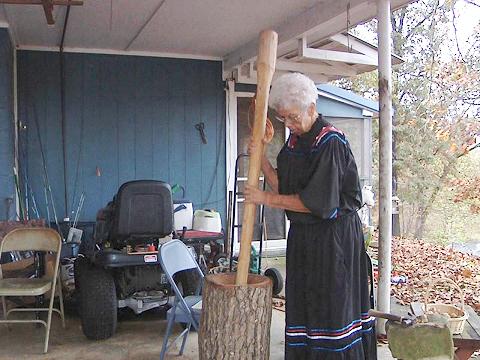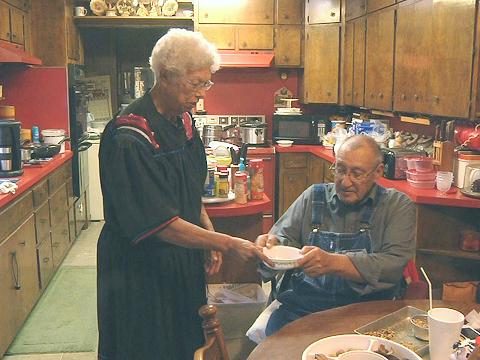 |
Canku Ota
|
 |
|
(Many Paths)
|
||
|
An Online Newsletter
Celebrating Native America
|
||
|
January 2016 - Volume
14 Number 1
|
||
|
|
||
|
Cherokee Treasure
Excels At Making Kanuchi
|
||
|
by Roger Graham - Cherokee
Phoenix Media Specialist
|
||
|
credits: all photos by
Roger J Graham - Cherokee Phoenix
|
STILWELL, OK – Since she began making it for her family as a young girl, 1992 Cherokee National Treasure Edith Knight has become an expert at making kanuchi, which is a traditional Cherokee meal made from hickory nuts. Knight received her National Treasure honor for making tear dresses. As for being an expert kanuchi maker, she said, "After I make it I never have any left." Knight also said there are good and bad years for hickory nuts. This year, the hickory trees surrounding her home did not produce at all. So she had to gather nuts from a friend whom she knew had Mockernut hickory trees. "My mother made it for many years, and I learned to make it just like she did," Knight said at her Adair County home. "You see there's different kinds of hickory nuts. I like to use the Mockernut hickory because it has a larger nut-meat and it has a better flavor." According to www.cherokee.org, hickory nuts are gathered in the fall and allowed to dry for a few weeks before the kanuchi making begins.
"Begin by cracking, then shelling the hickory nuts by shaking the pieces through a loosely woven basket, or picking them out by hand," the website states. "Traditionally, a section of log or a tree stump was hollowed out into a bowl-like shape. The shelled hickory nuts are placed in the hollowed log bowl and pounded with a long heavy stick until they are of a consistency that can be formed into a ball that will hold its shape. Kanuchi balls are usually about 3 inches in diameter and must be stored in a cold place. Today kanuchi is usually preserved by freezing." In today's world, kanuchi is considered a delicacy although it is believed to have been used as a filler when food was scarce. "I believe sometimes in the long past kanuchi might have been all they had to eat. It was one of the few foods they could store because of it coming from the hull," Knight said. Knight said kanuchi is sometimes made with corn or hominy and seasoned with salt, although her family has always preferred to mix the hickory solution with rice and add sugar. She said today most people don't use the traditional "kanon" or hollowed out log to contain the crushed nuts. "The idea is to keep hammering until the nut meat rises to the top and the oils begin to make it stick together. That's how you make a kanuchi bowl." During the kanuchi-making process, Knight said she advises to start cooking the rice early and to always sift and boil the slurry twice before proceeding. She said that gets rid of all the bacteria. "Remember we pick these (hickory nuts) up off the ground." Portions of the kanuchi ball can be saved and refrozen, depending on the number of those eating. Once the kanuchi-slurry is mixed with the rice and the proper amount of sugar is added, Edith hands the bowl of kanuchi to her husband Owen, who's served as her kanuchi tester for almost six decades. After tasting the finished product, Owen said, "It's good. I think you did real good." |
||||
|
|
|
|
||
|
|
||
| Canku Ota is a free Newsletter celebrating Native America, its traditions and accomplishments . We do not provide subscriber or visitor names to anyone. Some articles presented in Canku Ota may contain copyright material. We have received appropriate permissions for republishing any articles. Material appearing here is distributed without profit or monetary gain to those who have expressed an interest. This is in accordance with Title 17 U.S.C. Section 107. | ||
|
Canku Ota is a copyright ©
2000 - 2015 of Vicki Williams Barry and Paul Barry.
|
||
 |
 |
|
|
The "Canku
Ota - A Newsletter Celebrating Native America" web site and
its design is the
|
||
|
Copyright ©
1999 - 2015 of Paul C. Barry.
|
||
|
All Rights Reserved.
|
||

